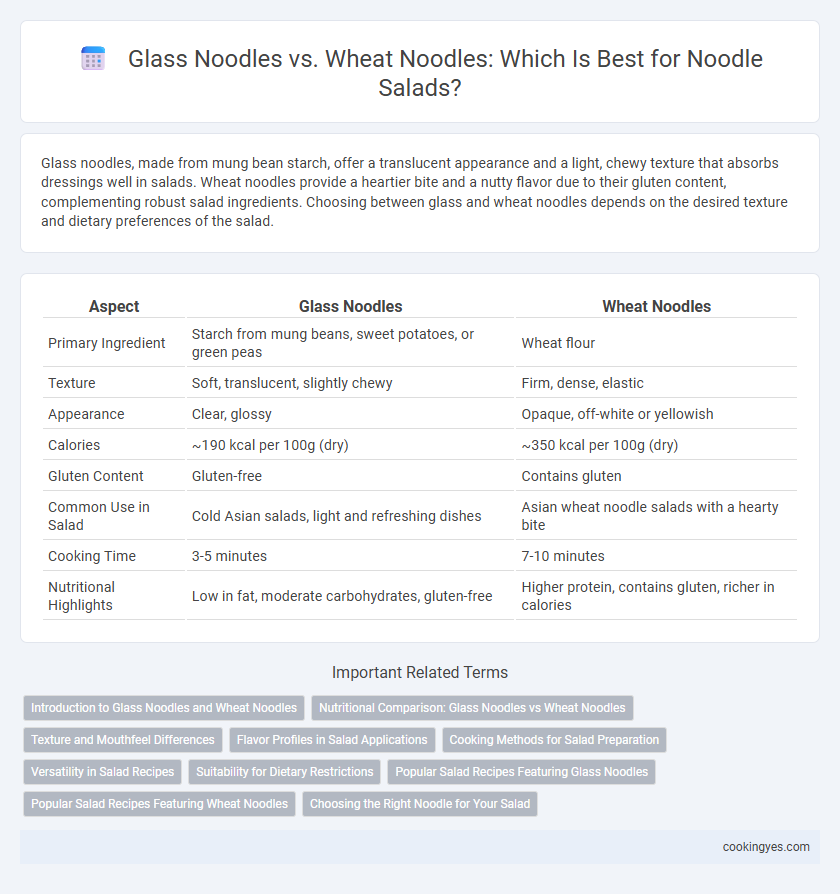Glass noodles, made from mung bean starch, offer a translucent appearance and a light, chewy texture that absorbs dressings well in salads. Wheat noodles provide a heartier bite and a nutty flavor due to their gluten content, complementing robust salad ingredients. Choosing between glass and wheat noodles depends on the desired texture and dietary preferences of the salad.
Table of Comparison
| Aspect | Glass Noodles | Wheat Noodles |
|---|---|---|
| Primary Ingredient | Starch from mung beans, sweet potatoes, or green peas | Wheat flour |
| Texture | Soft, translucent, slightly chewy | Firm, dense, elastic |
| Appearance | Clear, glossy | Opaque, off-white or yellowish |
| Calories | ~190 kcal per 100g (dry) | ~350 kcal per 100g (dry) |
| Gluten Content | Gluten-free | Contains gluten |
| Common Use in Salad | Cold Asian salads, light and refreshing dishes | Asian wheat noodle salads with a hearty bite |
| Cooking Time | 3-5 minutes | 7-10 minutes |
| Nutritional Highlights | Low in fat, moderate carbohydrates, gluten-free | Higher protein, contains gluten, richer in calories |
Introduction to Glass Noodles and Wheat Noodles
Glass noodles, made from mung bean starch, are translucent and gelatinous with a light, chewy texture perfect for absorbing salad dressings and flavors. Wheat noodles, derived from wheat flour, offer a firmer bite and a slightly nutty taste that complements crunchy vegetables in salads. Both types provide unique textures and nutritional profiles, making them popular choices for refreshing and versatile salad bases.
Nutritional Comparison: Glass Noodles vs Wheat Noodles
Glass noodles, made from mung bean starch, are low in calories and fat while providing a gluten-free option ideal for salads. Wheat noodles contain more protein, fiber, and essential nutrients such as B vitamins and iron, contributing to better satiety and overall nutritional value. For salads, glass noodles offer a lighter, hypoallergenic choice, whereas wheat noodles deliver higher nutritional density beneficial for energy and digestion.
Texture and Mouthfeel Differences
Glass noodles offer a smooth, slippery texture with a slightly chewy bite that holds dressings well in salads, providing a refreshing mouthfeel. Wheat noodles deliver a firmer, denser consistency with a more substantial chew and a slightly nutty flavor, enhancing the salad's heartiness. The contrast in texture between the translucent, delicate glass noodles and the opaque, robust wheat noodles significantly affects the overall sensory experience of a noodle-based salad.
Flavor Profiles in Salad Applications
Glass noodles offer a neutral, subtly sweet flavor that absorbs salad dressings and enhances fresh vegetable ingredients without overpowering. Wheat noodles bring a mild, wheaty taste and firmer texture that adds heartiness and complements robust, savory dressings. Choosing between glass and wheat noodles in salads depends on whether a light, translucent element or a textured, chewy base is preferred to balance flavor profiles.
Cooking Methods for Salad Preparation
Glass noodles require soaking in hot water for 5-7 minutes until tender but not mushy, preserving their translucent texture ideal for salads. Wheat noodles benefit from boiling for 3-4 minutes until al dente, then rinsing with cold water to stop cooking and maintain firmness, enhancing their chewiness in salad dishes. Both types should be drained thoroughly and tossed with a light dressing to prevent clumping and retain their distinct textures.
Versatility in Salad Recipes
Glass noodles offer exceptional versatility in salad recipes due to their neutral flavor and translucent texture, allowing them to absorb a variety of dressings and complement fresh vegetables or proteins seamlessly. Wheat noodles provide a heartier texture and slightly nutty taste, making them ideal for salads that benefit from a more substantial bite and robust flavor profile. Both types adapt well to diverse culinary styles, but glass noodles excel in light, refreshing salads, while wheat noodles suit more savory and textured preparations.
Suitability for Dietary Restrictions
Glass noodles, made from mung bean or sweet potato starch, are naturally gluten-free, making them ideal for individuals with celiac disease or gluten intolerance. Wheat noodles contain gluten, which can trigger adverse reactions in those with gluten sensitivities or wheat allergies, limiting their suitability for gluten-free diets. For salad recipes catering to dietary restrictions, glass noodles provide a safe and versatile option without compromising texture or flavor.
Popular Salad Recipes Featuring Glass Noodles
Glass noodles, made from mung bean starch, offer a translucent, chewy texture that absorbs flavors well, making them a favorite in popular salad recipes such as Thai Yum Woon Sen and Vietnamese glass noodle salad. Wheat noodles, on the other hand, have a denser bite and a slightly nutty flavor that works better in heartier or warm salads like sesame wheat noodle salad. Glass noodles are preferred in light, refreshing salads due to their gluten-free nature and ability to complement vibrant, tangy dressings.
Popular Salad Recipes Featuring Wheat Noodles
Wheat noodles offer a chewy texture and nutty flavor that complements popular salad recipes like Asian chicken noodle salad and cold sesame noodle salad. These salads often combine wheat noodles with fresh vegetables, crunchy peanuts, and tangy dressings for a balanced taste profile. Wheat noodles retain their firmness better than glass noodles, making them ideal for salads that require tossing and marinating.
Choosing the Right Noodle for Your Salad
Glass noodles, made from mung bean starch, offer a light and translucent texture that absorbs dressings well, making them ideal for fresh, vibrant salads. Wheat noodles provide a chewier bite and a more robust flavor, suitable for heartier salads that include rich ingredients or proteins. Selecting between glass and wheat noodles depends on the salad's texture balance and ingredient intensity to achieve the perfect harmony.
Glass noodles vs Wheat noodles for salad Infographic

 cookingyes.com
cookingyes.com